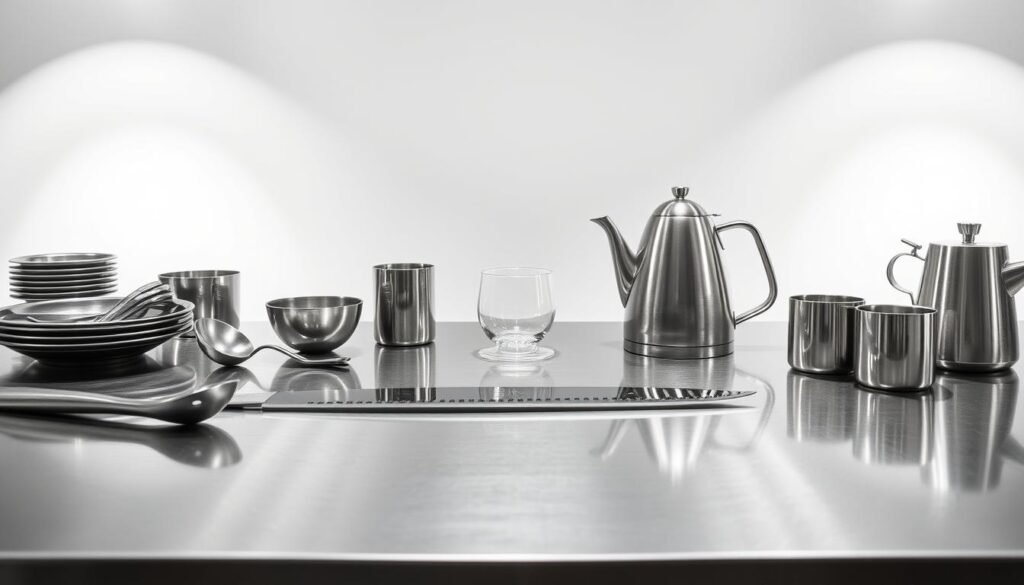18/8 stainless steel is a popular grade of stainless steel, known for its durability and resistance to corrosion. It belongs to the 300 series, with grade 304 being one of its most common classifications.
The composition of this material is primarily 18% chromium and 8% nickel, with the balance being mostly iron and a trace amount of carbon. This unique composition gives 18/8 stainless steel its notable corrosion resistance and makes it a preferred choice for various applications.
Understanding the properties and limitations of 18/8 stainless steel is crucial for selecting the right material for industrial, commercial, and domestic uses. Its corrosion resistance properties, while excellent, can be affected by exposure to certain environments, such as saltwater.
Understanding 18/8 Stainless Steel: Composition and Basic Properties
To grasp the significance of 18/8 stainless steel, it’s essential to understand its fundamental composition. This alloy is not just defined by its chromium and nickel content but also by other elements that contribute to its overall properties.
The Meaning Behind the Numbers: 18% Chromium and 8% Nickel
The designation “18/8” refers to the percentages of chromium and nickel in the alloy. Chromium provides corrosion resistance, forming a protective oxide layer on the surface. Nickel adds to the corrosion resistance and enhances the material’s formability and ductility. This combination is crucial for the alloy’s performance in various environments.
The presence of 18% chromium and 8% nickel is what gives 18/8 stainless steel its characteristic resistance to corrosion and its ability to be shaped without losing integrity.

Other Components: Iron, Carbon, and Trace Elements
Apart from chromium and nickel, 18/8 stainless steel is primarily composed of iron, which is the base metal. Carbon is another significant element, though it’s kept at low levels to prevent carbide precipitation, which can lead to corrosion. Other trace elements may be present, contributing to the material’s overall strength and corrosion resistance.
Key Physical and Mechanical Properties
18/8 stainless steel is known for its impressive tensile strength and its ability to be hardened through cold working. Its austenitic structure means it is non-magnetic and can’t be hardened by heat treatment. The material’s formability and ductility make it versatile for manufacturing processes. Additionally, its corrosion resistance is a key property, although it has limitations in chloride-rich environments.
The combination of these properties makes 18/8 stainless steel a popular choice for a wide range of applications, from kitchen utensils to industrial equipment.
What is 18/8 Stainless Steel Compared to Other Grades?
To appreciate the value of 18/8 stainless steel, it’s essential to compare it with other commonly used grades in the industry. This comparison will help in understanding the unique characteristics and applications of 18/8 stainless steel.
18/8 vs. 304 Stainless Steel: Are They the Same?
One of the most common comparisons made is between 18/8 and 304 stainless steel. In many contexts, 18/8 and 304 stainless steel are considered equivalent because they share similar compositions, with 18% chromium and 8% nickel being key components. However, the exact composition can vary slightly between the two, with 304 stainless steel having a broader range of acceptable chromium and nickel content.
The similarity in composition means that both grades offer good corrosion resistance and durability. However, 304 stainless steel is more formally defined by the American Society for Testing and Materials (ASTM) standards, which can make it a preferred choice for applications where specific material standards must be met.
18/8 vs. 316 Stainless Steel: Key Differences
When comparing 18/8 stainless steel to 316 stainless steel, the primary difference lies in the addition of molybdenum in 316 stainless steel. This addition significantly enhances its corrosion resistance, particularly against chlorides and other corrosive substances.
316 stainless steel is more resistant to pitting and crevice corrosion than 18/8 stainless steel, making it a preferred choice for marine environments or applications involving exposure to high levels of chlorides.
18/8 vs. 18/10 and 18/0 Stainless Steel
The numbers in 18/10 and 18/0 stainless steel designations also describe their composition. 18/10 stainless steel contains 18% chromium and 10% nickel, giving it slightly better corrosion resistance than 18/8 stainless steel. This makes 18/10 a popular choice for high-quality kitchenware and flatware.
In contrast, 18/0 stainless steel contains 18% chromium but no nickel. The absence of nickel reduces its corrosion resistance compared to 18/8 and 18/10, but it is also more affordable. The choice between these grades depends on the balance between required performance and budget constraints.
The nickel content not only affects corrosion resistance but also the appearance of the stainless steel. Higher nickel content typically results in a brighter, more lustrous finish.
Applications and Uses of 18/8 Stainless Steel
With its excellent corrosion resistance and durability, 18/8 stainless steel finds applications in multiple sectors. Its versatility is a result of its unique composition and properties, making it a popular choice for various industries.

Food and Kitchen Applications
18/8 stainless steel is widely used in the food industry due to its resistance to corrosion and ease of cleaning. It is commonly found in kitchen utensils, cookware, and appliances. The material’s ability to withstand various environments, including exposure to water and oxygen, makes it ideal for food preparation and processing.
Industrial and Commercial Uses
In industrial settings, 18/8 stainless steel is utilized for its strength and resistance to corrosion. It is used in the manufacture of equipment and machinery that are exposed to harsh environments. The metal’s durability ensures that it remains functional over extended periods, reducing maintenance costs.
Medical and Healthcare Applications
The healthcare industry benefits from the use of 18/8 stainless steel in medical equipment and instruments. Its non-reactive nature and ease of sterilization make it an ideal material for medical applications. The corrosion resistance of 18/8 stainless steel is particularly valuable in environments where cleanliness is paramount.
Limitations: Where Not to Use 18/8 Stainless Steel
Despite its many advantages, 18/8 stainless steel has limitations. It is not suitable for use in marine environments or applications where it will be exposed to high levels of chloride, as this can lead to corrosion. Additionally, its non-magnetic properties make it unsuitable for applications requiring magnetic materials. High-temperature environments exceeding approximately 800°F (425°C) can also compromise its corrosion resistance due to chromium carbide precipitation. Furthermore, 18/8 stainless steel can be susceptible to stress corrosion cracking when exposed to tensile stress and corrosive environments simultaneously.
Conclusion: Is 18/8 Stainless Steel Right for Your Needs?
To determine if 18/8 stainless steel is the right choice for your needs, it’s essential to evaluate its characteristics and applications. 18/8 stainless steel is renowned for its excellent corrosion resistance, making it suitable for many environments. However, it can show signs of corrosion when exposed to chlorides, such as salt, which is not ideal for marine applications.
The composition of 18/8 stainless steel, which includes 18% chromium and 8% nickel, provides a good balance of corrosion resistance, durability, and cost-effectiveness for many common applications. Its properties include impressive strength, the ability to bend and mold without losing durability, and it is highly cost-effective. This type of stainless steel also requires minimal maintenance, making it an attractive option for various applications.
When deciding whether to choose 18/8 stainless steel over other grades like 316 for non-marine applications, or opting for 18/10 for premium kitchenware or 18/0 for budget-conscious projects, understanding the specific environmental conditions, performance requirements, and budget constraints is essential. 18/8 stainless steel represents an excellent middle-ground option that satisfies the requirements for most everyday applications while remaining cost-effective compared to higher-grade alternatives.
